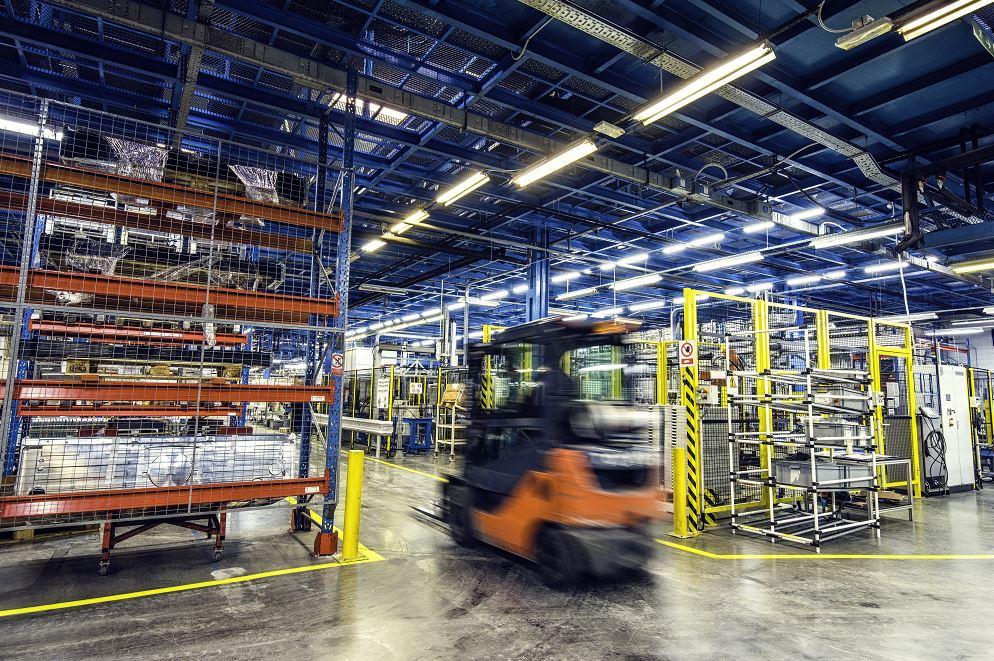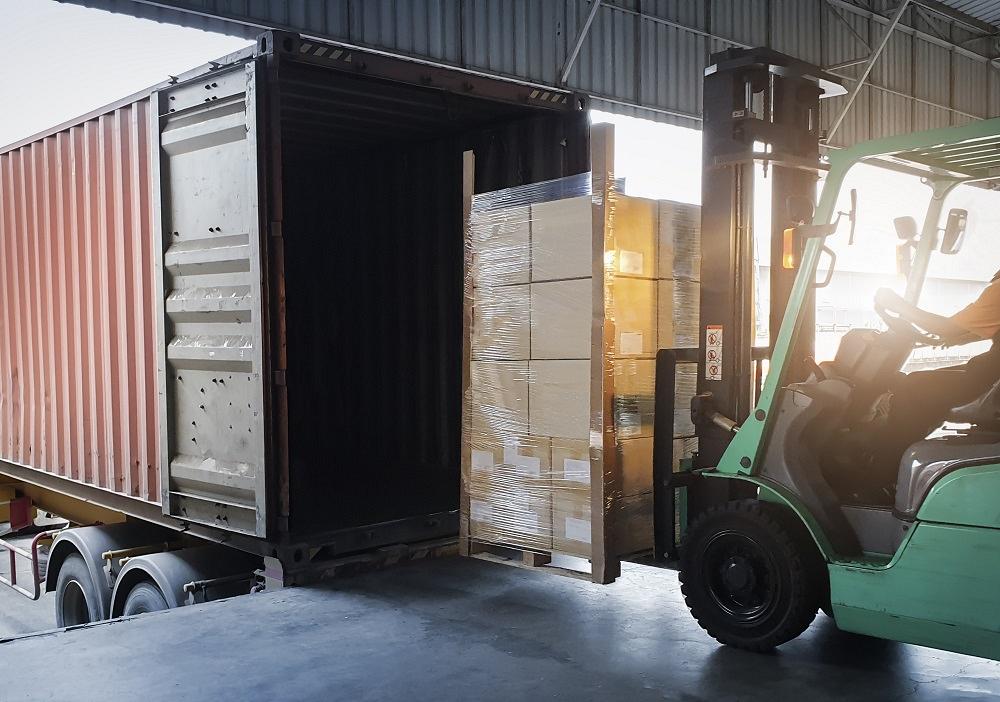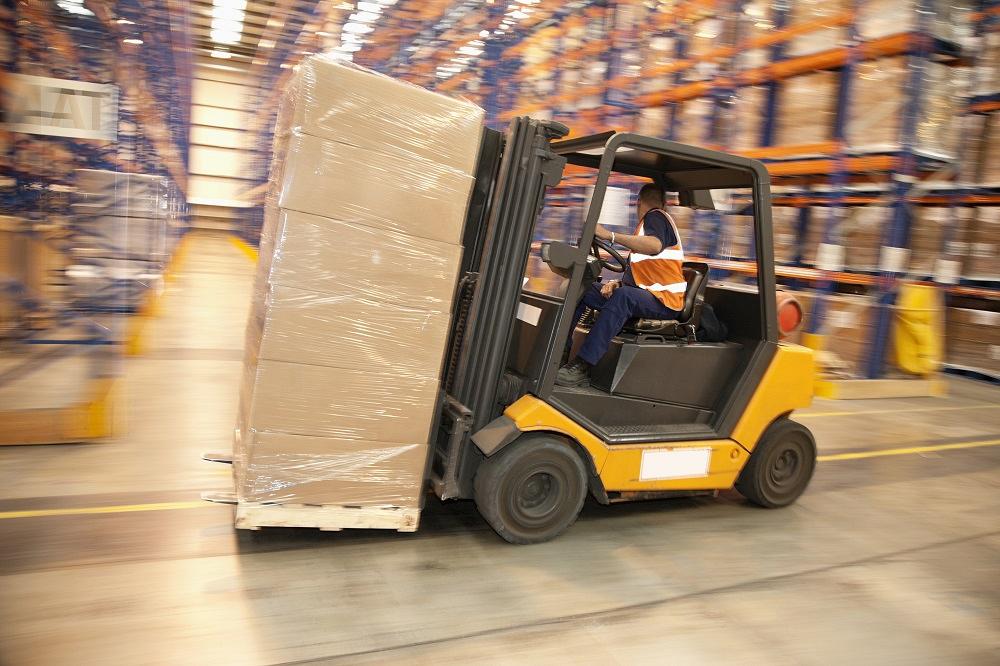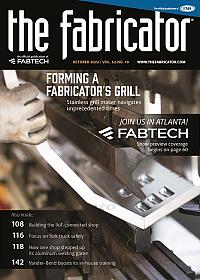Editor-in-Chief
- FMA
- The Fabricator
- FABTECH
- Canadian Metalworking
Categories
- Additive Manufacturing
- Aluminum Welding
- Arc Welding
- Assembly and Joining
- Automation and Robotics
- Bending and Forming
- Consumables
- Cutting and Weld Prep
- Electric Vehicles
- En Español
- Finishing
- Hydroforming
- Laser Cutting
- Laser Welding
- Machining
- Manufacturing Software
- Materials Handling
- Metals/Materials
- Oxyfuel Cutting
- Plasma Cutting
- Power Tools
- Punching and Other Holemaking
- Roll Forming
- Safety
- Sawing
- Shearing
- Shop Management
- Testing and Measuring
- Tube and Pipe Fabrication
- Tube and Pipe Production
- Waterjet Cutting
Industry Directory
Webcasts
Podcasts
FAB 40
Advertise
Subscribe
Account Login
Search
How to avoid forklift injuries and fatalities
Taking precautions and following best practices can keep people safe in metal fabricating facilities

Forklifts are valuable tools in helping to keep manufacturing facilities going. They also can be very dangerous devices if the operators are not paying attention or take unnecessary risks. Vm/E+/Getty Images
Forklifts are necessary devices in most manufacturing facilities. They are effective at transporting raw materials, work in process, and finished goods to the places where they need to be to ensure that workflow remains steady and goods are delivered per schedules.
Forklifts also can be dangerous—and even deadly—devices.
Each year since 2011, more than 50 people have died in the U.S. in forklift-related accidents across all industry sectors. In the same time period, more than 6,000 people suffered nonfatal injuries as a result of forklifts. When a 10,000-lb. vehicle hits a 180-lb. human, the human isn’t going to fare too well.
That’s the bad news. The good news is that training, smart work procedures, and engaged employees really can make a difference. Just consider this: The number of warehouse workers in the U.S. has more than doubled over the past 10 years, from 707,100 in January 2013 to 1,791,100 in June 2022, according to the Bureau of Labor Statistics. But the number of injuries and fatalities hasn’t spiked with the increased number of workers.
But any death in a work situation is one too many, and any accident involving a forklift is likely to require more than a bandage or some ice to get the injured party back to work quickly. That’s why forklift safety is so important, particularly in manufacturing settings where just over a quarter of all nonfatal forklift-related injuries occur in the U.S.
To stress the importance of forklift safety, The FABRICATOR spoke with Holly Pups, an editor covering environmental, health, and safety issues with J.J. Keller & Associates WWW.JJKELLER.COM, a provider of safety-related products and services. Because Pups is a former Occupational Safety and Health Administration (OSHA) compliance officer and has more than a decade of industrial safety experience in the private sector, The FABRICATOR also presented her with some real-world fatality scenarios from the OSHA archives and asked her how these situations could have been prevented. An edited version of the conversation follows.
The FABRICATOR: What do you see as being the main factor in forklift accidents?
Holly Pups: The two big things that I see based on my experiences is that there’s a really big difference between the direct cause and the root cause of an accident. The direct cause for forklift incidents of any kind, whether it’s property damage, a near miss, or a case where somebody gets hurt, is very often something like the operator being distracted. They weren’t paying attention. But the root cause is related to why they were distracted. Is it because the driver was tired? Has the driver been working too much overtime? If the driver missed a break, did he not get to schedule it later on?
So, the schedule and workload of the forklift operators are really important. But management being aware of what makes sense for forklift drivers and what is safe for the employees is where you have the biggest opportunity for improvement when it comes to forklift safety.
FAB: Are the training requirements for forklift drivers the same across all industries?

FIGURE 1. Good communication is often relied upon to ensure that a semitruck and trailer doesn’t take off with a forklift still in the trailer. But the safest tool to ensure the safety of the load and the forklift operator might be an automatic dock lock system that keeps the trailer in place until the forklift operator presses a button to release a trailer from the dock. 1933bkk/iStock/Getty Images Plus
Pups: OSHA’s General Industry standard covering forklifts captures basically anything that is not construction, maritime, or agriculture. It’s all covered under 29 CFR 1910.178, which covers powered industrial trucks. With that, it also covers forklifts, reach trucks, and the variety of vehicles used to move materials.
FAB: What does OSHA require of drivers in terms of training or credentialing?
Pups: Again, this is captured under 1910.178. The training requirements for operators is that they have a classroom portion of training where you can have a combination of instruction, video, demonstrations with trucks, or whatever makes sense for your facility. Then there’s supposed to be a hands-on demonstration. So, you would have a qualified forklift operator show them the controls and then have that same qualified forklift operator supervise them as they got used to that particular truck. They have to be evaluated by the trainer to make sure that they are operating well enough that they aren’t going to create a hazard for the facility. This is required for each type of industrial truck.
FAB: Are these training programs generally pretty good in terms of providing forklift operators the information they need to be effective and to maintain a safe work environment?
Pups: It depends on the facility and on the mindset. Based on both my personal experience and definitely what I saw in my time as an OSHA compliance officer, forklift training really is a kind of a pencil-whipped activity. I’ve seen companies do an hour-long training with hands-on classroom and evaluation all completed in that hour.
Early in my career, I was put in a similar situation. But it didn’t feel right.
What I ended up doing is creating a robust training program. I had the classroom portion where I could talk about the regulations and safety tips, such as how the weight might shift on the forklift. Then I put the accountability for the demonstration and evaluation on the managers or the supervisors of the department where the employee was going to work. Those supervisors need to be comfortable with this person handling our product.
FAB: What would you like to see changed when it comes to OSHA requirements?
Pups: The biggest change that I would like to see when it comes to training is OSHA outlining the requirements for trainers. Right now, it just says anyone that has sufficient knowledge can be a trainer. So, it’s experience and knowledge, but it’s a really big gray area for individual companies to interpret in a way that makes sense for them. That’s not necessarily a benefit to the employees because they’re not getting the detailed training that they likely need.
FAB: You mentioned the fact that overworked employees could lead to a lack of focus for forklift drivers. Do you see that as the biggest challenge when it comes to forklift safety, or are there other factors that people should be aware of?

FIGURE 2. With no way to see what’s ahead with a load on the fork blocking the view, the only safe direction a forklift driver can go is backwards. Clerkenwell/Vetta/Getty Images
Pups: Finding enough staff is always a struggle across the board, and that relates to what I see as the biggest challenge to keeping employees safe. It’s not just limited to powered industrial trucks. Companies have the expectation that employees are going to pick up the slack when other roles go unfilled. As a result, people are working a lot more.
Companies want to keep going because they are making money, but employees just can’t do six 16-hour days in a row. That is going to increase your chances of accidents and of significantly hurting somebody else.
There are other challenges too, kind of going back to these staffing issues. So, by the time these short-staffed companies do get somebody on hand, that new hire, who might have little to no experience, is expected to get working. Training costs, so we have a tendency to rush through things like forklift training or lockout/tagout training.
In manufacturing, people spend a lot of time talking about “right first time,” avoiding mistakes by taking the time to do things right the first time. That needs to apply to training as well. If we take the time to do the training correctly, it is thorough, and we have a really good feel for that employee, then we can let the employee loose. But if you rush the training and the expectations just to get them out on the floor, it ends up costing employers in the long run because these are the guys that take out racks, dropping thousands of dollars’ worth of product. Or, heaven forbid, they pin somebody against a rack.
FAB: Sometimes the best way to understand the importance of a subject like forklift safety is to talk about real-world examples. With that in mind, we’d like to talk about some forklift accidents, mentioned on the OSHA website, and have you comment on how these unfortunate incidents could have been avoided.
The first example involves a forklift that tipped over while the operator was apparently making a sharp turn at an excessive speed. No seat belt was installed, and when the employee fell from the seat, he was crushed by the rollover bar. What comes to mind when you think about this accident?Pups: Obviously, the direct cause of this accident is the fact that this person was going too fast. But it’s also important to note that the root cause was the operator didn’t have a seat belt on.
While OSHA does not require that forklifts have seat belts, it does require that if the forklift is equipped with one, then the operator is required to use it.
However, under the general duty clause, which is sort of a catch all for subjects like this, OSHA does explain in a letter of interpretation that forklifts should be retrofitted to have seat belts because this is a known hazard. If the forklift tips over, you’re wearing your seatbelt, it’s going to hurt like nobody's business, but it’s not going to kill you.
The understanding is that you would have these retrofitted. I believe the newer updates from the ANSI or ASME standards require that forklifts be equipped with them now. But there are still lifts out there from previous editions that are not required to have it.
Going back to the fact that the operator was going too fast, there is an unspoken rule that forklifts inside shouldn’t be going more than walking speed. But that can be difficult for a driver in a huge facility, especially if you’ve got a propane-powered forklift, which has a little extra power.
In training, speed is something that should be addressed. OSHA does not give you an exact mile per hour, and most of these forklifts are not equipped with a speedometer. But you have to drive for the conditions.
FAB: In this next incident, an operator was driving a stand-up forklift into a tractor to start unloading when the truck driver pulled away from the dock. The forklift fell back onto the driver, striking his head, and breaking his neck. What could have been done to prevent this deadly scenario?
Pups: This is a situation where the hierarchy of controls could have made a difference. This is a situation where a truck is pulling away and you have potential for a forklift falling; the hierarchy of controls suggests that you take the appropriate steps to eliminate this potential hazard.
You’re not going to take forklifts out of trucks, so the next step down would be your engineering controls. These don’t rely on people so much as they are more about systems in place that would help prevent an injury or a fatality.
Then there are administrative controls, which is where most companies end up at (see Figure 1). They tell the driver of the truck to turn the truck off or sit in the lounge while loading or unloading takes place. There’s a lot of room for error with this type of administrative control. For example, the driver gets a call and says that he’s got to go. He takes a peek in the trailer and nobody’s in there. But he pulled off not knowing that the guy isn't done, and an accident occurs.
When I was in the field, I tried to get away from those administrative controls that rely on communication because there are different companies and people, and everyone’s schedules and training is going to be a little bit different. So, my preference for these situations are things like automatic dock locks, which are devices that essentially secure the trailer to the building. The forklift operator is in control of this and controls when the truck can leave with the press of a button, which unlocks the truck. Of course, it’s not a 100% guarantee that the truck driver isn’t going to pull off, but it’s a big deal if they do while being locked to the dock.
FAB: This incident involves an obstructed view of the driver. As the operator is driving the forklift and cannot see properly in front of him, the forklift strikes an employee walking by, killing him. What’s the first thing that jumps out at you here?
Pups: It is an OSHA requirement that if you have a load that’s blocking your view, you have to drive backwards (see Figure 2), or there has to be some alternative means for the operator to have the forward view unobstructed.
This can be tricky because some people don’t understand what unobstructed really means. I remember when I worked for a company that had an employee who was 6 ft., 7 in. tall, and he thought he had an unobstructed view on the forklift even when the pallet was loaded to about a height of 6 ft. tall. He could see over it, but it’s like putting your hand at your nose. You can’t see what’s below your hand. He could only see at a distance, not what was right in front of him. That wasn’t a good situation.
This is where training can make a difference. One of my favorite ways to train is to sit down at a table, have a conversation, and play with trucks. It was a good way to talk about situations and then provide a hands-on exercise to make the discussion come alive. What problems do you see here? If you have a load that blocks your view, which way do you need to drive? It’s an ongoing conversation.
A lot of companies forget that they should be continually reminding folks about their training. If you only get the training every three years or when you have an accident, then that’s a little too late.
FAB: Here’s one more fatality linked to poor forklift operation. Two employees were riding the load, which was tied onto the forks of a forklift. The load was being lifted with the aid of a crane. The men were standing on the load as it was lifted about 23 ft. in the air. The load shifted and slipped off the forks, propelling the two men off the load. One man was seriously injured, and the other died of his injuries.
Pups: There are a lot of problems here. First off, no one is allowed to ride the load, especially not two people. The only exception to that is they have man cages that you can attach to the forklift, but even those are still not recommended.
The operator, riders, and crane operator all had a part here, which indicates there is a systematic issue that may boil down to insufficient training.
FAB: Do you have any final thoughts for manufacturers looking to minimize the risk of injury resulting from a forklift accident?
Pups: I actually have three points, two of which we have somewhat covered already. First, you need a thorough training program, and you need to focus on putting the emphasis on doing it right the first time when it comes to training employees. Take that extra time. Make sure the employees are extra comfortable.
The next one has to do with company setting reasonable expectations for employees, who are trying to please and will rush. Sometimes employees set unrealistic expectations for themselves. This is where communication from the chain of command is really important. A manager should not be afraid to say, “I see you’re rushing. You’re going a little fast. Well, why are you doing that?” If the employee is rushing so he doesn’t miss a break, the manager should reassure him that the break can be taken five minutes later. That communication circle is key.
And the biggest one that we haven’t really talked about, which is one of my more controversial beliefs in running an effective safety program, is when incidents or accidents do occur, don’t blame the employee. The mindset of many businesses was that if someone screws up, he gets suspended so that they know not to do it again. That does a lot more harm than good. It makes people less likely to report things. It makes them feel like if they screw up that they’re going to lose their job.
When accidents or incidents are occurring, these are opportunities to understand what’s actually happening on that shop floor. It gives the manager a chance to find out the employee’s trials and tribulations that might have influenced the accident and take steps to avoid a similar accident in the future.
At one of my previous jobs, we had a rash of collisions with forklifts and roll-up doors. After such an incident, it would have been easy enough to send a forklift operator home without pay for four days. Well, then everyone else is having to cover that employee’s work, and they’re getting more stressed. They’re more likely to have an accident. Also, the suspended employee feels bad about himself and his job.
But if you get to the root cause, you find the real truth. I investigated these roll-up doors, and it was because the roll-up doors were unbelievably fast. The company actually had to spend nearly $100,000 to add effective safety controls around these doors. It wasn’t the employee trying to rush the door; it was the door rushing the employee.
So, when you are seeing these accidents, it’s an opportunity to take a look at what’s going on. Anytime an employee is involved in a near hit or near miss involving a forklift or other powered industrial truck, they are required to receive some training. At that time, you can address what was done wrong and frame it as a learning opportunity.
About the Author

Dan Davis
2135 Point Blvd.
Elgin, IL 60123
815-227-8281
Dan Davis is editor-in-chief of The Fabricator, the industry's most widely circulated metal fabricating magazine, and its sister publications, The Tube & Pipe Journal and The Welder. He has been with the publications since April 2002.
Related Companies
subscribe now

The Fabricator is North America's leading magazine for the metal forming and fabricating industry. The magazine delivers the news, technical articles, and case histories that enable fabricators to do their jobs more efficiently. The Fabricator has served the industry since 1970.
start your free subscription- Stay connected from anywhere

Easily access valuable industry resources now with full access to the digital edition of The Fabricator.

Easily access valuable industry resources now with full access to the digital edition of The Welder.

Easily access valuable industry resources now with full access to the digital edition of The Tube and Pipe Journal.
- Podcasting
- Podcast:
- The Fabricator Podcast
- Published:
- 04/16/2024
- Running Time:
- 63:29
In this episode of The Fabricator Podcast, Caleb Chamberlain, co-founder and CEO of OSH Cut, discusses his company’s...
- Industry Events
16th Annual Safety Conference
- April 30 - May 1, 2024
- Elgin,
Pipe and Tube Conference
- May 21 - 22, 2024
- Omaha, NE
World-Class Roll Forming Workshop
- June 5 - 6, 2024
- Louisville, KY
Advanced Laser Application Workshop
- June 25 - 27, 2024
- Novi, MI































